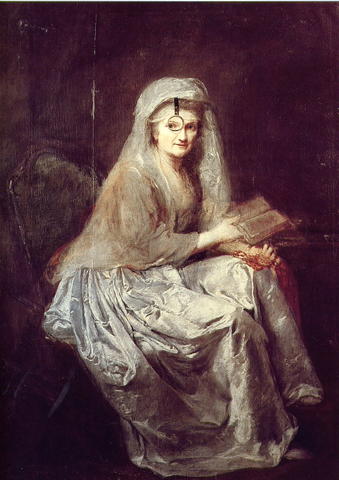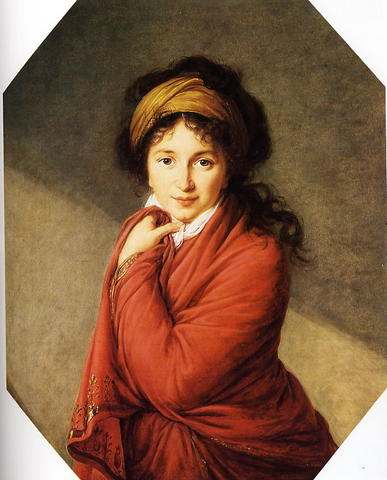Ellen and Jim Have a Blog, Too
We are two part-time academics. Ellen teaches in the English department and Jim in the IT program at George Mason University.


Women's lives, art & books: at Montreal · 14 April 06
Dear Marianne,
I could divide up the papers I heard Friday into those which emphasized the real lives of women in the 18th century, and those which dwelt on the problems of becoming a successful serious artist and writer.

Anna Dorothea Therbusch (1721-1782), Self-Portrait (1762)
The first session I went to on Friday had a group of papers about real life marriage customs in the 18th century. The first paper showed how the content of popular ephemeral plays of the 1790s and early 19th were fantasies which reflected the traumas and wish-fulfillment dreams of the time. Men thought dead return to their families and wives; people who would be overwhelmed by and fight bitterly with other family members over debts are spared because someone agrees to pay more than is needed. Napoleon apparently encouraged people to marry before going off to war by paying them large sums; these plays show the dislocating results of such state-sponsored marriages.
A second paper was supposed to have been how actual marriage contracts affected the couple at the center of a group of novels; the speaker said she discovered most novels never go into enough detail or have sufficient exactitude to detail a contract. So instead she discussed the letters of Isabelle de Charrière where Charrière reveals her experience of having been courted at length by more than one suitor, and finally married.
The second session for me that day had the longest title of any in the conference: "The Histories of the Penitents in the Magdalen-House (1760): Sentimental Constructions of Prostitution and Feminity in the Mid-Century Charity Movement." This was a roundtable of 5 10 minute papers plus a 5 minute informative introduction about a 2 volume novel called The History of Some of the Penitents inthe Magdalen-House supposed to have been written by themselves. I’ve such such minor volumes made up of short novellas of heroine’s texts where the heroine lives a highly unconventional life—she is often not respectable because she’s been unchaste in order to survive. Apparently it had recently been thought this book was written by Sarah Fielding, but private letters between Barbara Montagu and Samuel Richardson and a gift to Richardson from Montagu’s brother after Richardson published this 3 volume set suggest the author was Barbara Montagu.
The individual papers were on different narrators and tales in the 2 volumes. Taken as a group, the tales highlight the realities of real family life, poverty, courtship, marriage, motherhood in the 18th century. The prostitutes are all now penitent and present themselves as victims of seduction: either they gave sex for love, or sex for money, and were betrayed. The pentitent narrators argue wives are prostitutes, de-mystify and reveal the difficulty of deciphering what is love. We find motherhood makes them vulnerable. Fiction spills in fact as the narrators show themselves to be obsessively concerned with presenting proof for the veracity of their accounts. Novel reading itself is presented as providing useful education for girls as long as they are truthful and not salacious. Prostitution itself was canvassed and, except that the tales do not portray in any kind of effective way male violence (there is no pimp in sight), the books sufficiently details cruelties and pressures inflicted on women in their quest to find security and personal fulfillment in heterosexual relationships.
The very last session I attended on Friday included a paper where the speaker analyzed Elisabeth Vigee-LeBrun’s real relationship with, and use of the idealized paintings of herself and her daughter. Vigée-LeBrun was exploitative and narcissicist. The speaker argued that had Vigée-LeBrun not been self-centered and ruthless she could not have had the monetarily and socially successful career she did. This session also had an informative paper on the reception history (critical responses to) the famous Memoir written by Manon Phlippon Roland while she was in prison, awaiting execution; the speaker argued it was of urgent importance to treat these frankly from the point of view of the woman’s real biography, to tell of how Roland’s father’s apprentice imposed himself sexually on her when she was a young teenager, to tell of Roland’s affairs, of her relationship with her husband, and her real thwarted ambition—and failure as a poltician because she was a woman.

Elisabeth Vigee-Lebrun (1755-1842), Countess Golovin (1797-1800)
Saturday morning I heard and participated in a rather moving session on Catherine Macaulay and a witty one on French women novelists of the later 18th and early 19th century. The sesssion on Macaulay was moving because two of the speakers were devoted scholars of Macaulay and spoke of her in glowing deeply empathetic terms. Her Letters on Education criticize and correct Rousseau’s Emile. She is not radical socially or economically like Wollstonecraft, but she is as determined to enable women to develop their gifts usefully for themselves and for society. She dealt with the problem of chastity, arguing that girls should be provided with a truer idea of what is beautiful and protected from sexual exploitation by building their pride and self-esteem. She saw the history of women as one where they are treated as the property of men. There was a paper comparing the work of a later 18th century American novelists, Judith Sargent Murray, with Macaulay’s.
A really fine paper ended the session with an informative analysis of Macaulay’s 8 volume history of England. Macaulay does include women throughout even though they are not the central actors; and among other things, spends much time detailing the history of the English civil war by including portraits of middle and upper class women who were influential and active or whose lives epitomize how the war affected women. The speaker argued that Macaulay’s class bias made her present lower class women’s actions in public as harmful. Macaulay understands that there is no easy sisterhood among women. Macaulay approves of the public efforts of gentlewomen in 1641 to present a petition courteously, and of Lady Russell’s politicking diplomatically, but she inveighs against women’s mob violence in 1843. The speaker insisted that Macaulay developed a humane civic ideal which is significant, one controlled by Macaulay’s own belief in a benevolent God. From these and other examples in the talk, it seemed to me that Macaulay was as much motivated by a fear and dislike of these women’s necessary violence (to be heard, to be felt they had to put their bodies on the line in crowds). She was also not realistic and wanted to uphold the class system which supported her. Since I find this era so fascinating and am eager to find time to work more on the women who were active, the specific information and point of view this speaker said Macaulay’s book’s has makes me feel maybe I should read parts of it.
The witty session was about "cross-channel conversations," i.e., translations of texts from one language to another (mostly French and English) and transitions between the subversive mores and reading audience for novels of the later 18th century and the return to piety and conservatism in novels and the enlarging commerical literary marketplace of the 19th. Novel writing and reading had been an acceptable pasttime for educated French women; it became a way for them to make money. They had done much translation (out of 150 novels published in France between the mid-18th and early 19th century 30 were translations); now they turned to write memoirs. I’ll single out one paper: on the now unknown Pauline de Moulin who translated Mary Hays’s Memoirs of Emma Courtney and transformed herself from a later 18th century novelist of risqué ambiguous sexual novellas into Madame Guizot, a sometimes cited and admired writer of didactic children’s stories. Her husband had at first helped her with her career, but after marriage she supported him and their children. Plus ça change … The career trajectory reminds me of Madame D’Arblay (our Fanny and Alexandre).
On Saturday noon occurred the panel where I gave my paper, "Women in Cyberspace." After that I attended the women’s caucus and, while eating lunch, renewed some friendships I had begun in the two previous ASECS sessions I attended (very cordial women, inspiriting talk), and then slipped away with Edward to walk in Mont Royal park.
You may be wondering who that alert old lady in the very fancy gown with the eyeglass, Anna Dorothea Therbusch was. Later in the week Sophie means to write about Therbusch’s life and painting to Anne.
Elinor
--
Posted by: Ellen
* * *
Comment
commenting closed for this article
